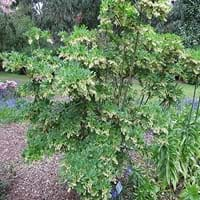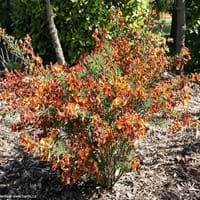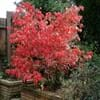Life Span
Perennial
Perennial
Origin
Southern Asia, India, Nepal, China
Hybrid origin
Types
Enkianthus campanulatus
Not Available
Habitat
Islands
open Woodlands, sandy seeps
USDA Hardiness Zone
7-9
6-8
Sunset Zone
6, 7, 8, 9, 14, 15, 16, 17, 18, 19, 20, 21
H1, 2a, 2b, 3a, 3b, 4, 5, 6, 7, 8, 9, 10, 14, 15, 16, 17, 18, 19, 20, 21, 22
Habit
Spreading
Spreading
Flower Color
Light Pink, Rose, Ivory
Yellow, Red, Lemon yellow
Flower Color Modifier
Bicolor, Striped
Bicolor
Fruit Color
Red, Green, Light Green
Black, Dark Brown, Tan
Leaf Color in Spring
Green, Light Green
Green
Leaf Color in Summer
Green
Green
Leaf Color in Fall
Red, Orange, Orange Red
Green
Leaf Color in Winter
Not Available
Green
Leaf Shape
Elliptic
Ovate
Plant Season
Spring, Fall
Spring, Summer, Fall, Winter
Sunlight
Partial Sun, Partial shade
Full Sun
Growth Rate
Very Slow
Fast
Type of Soil
Clay, Loam, Sand
Clay, Loam, Sand
The pH of Soil
Acidic, Neutral
Acidic, Neutral, Alkaline
Soil Drainage
Well drained
Well drained
Bloom Time
Late Spring, Early Summer
Spring, Late Spring, Early Summer
Tolerances
Drought, Salt
Salt
Where to Plant?
Ground, Pot
Ground, Pot
How to Plant?
Stem Planting
Hardwood Cuttings, Stem Cutting
Plant Maintenance
Low
Medium
Watering Requirements
Do Not over Water, Keep ground moist, Keep the ground moist but not water-logged, Never Over-water, Requires regular watering, Water less during winter, Water more in summer
Do not water excessively, Does not require lot of watering
In Summer
Lots of watering
Lots of watering
In Spring
Average Water
Moderate
In Winter
Average Water
Average Water
Soil pH
Acidic, Neutral
Acidic, Neutral, Alkaline
Soil Type
Clay, Loam, Sand
Clay, Loam, Sand
Soil Drainage Capacity
Well drained
Well drained
Sun Exposure
Partial Sun, Partial shade
Full Sun
Pruning
Prune if you want to improve plant shape, Remove damaged leaves, Remove dead leaves, Remove dead or diseased plant parts
Remove damaged leaves, Remove dead branches, Remove dead leaves
Fertilizers
fertilize in spring, Nitrogen
All-Purpose Liquid Fertilizer, Apply N-P-K
Pests and Diseases
Insects, Red blotch
Not Available, Red blotch
Plant Tolerance
Drought, Salt
Drought, Dry soil, Pests and diseases, Wet Site
Flower Petal Number
Single
Semi-Double
Foliage Texture
Medium
Fine
Foliage Sheen
Matte
Matte
Attracts
Not Available
Butterflies
Allergy
Not Available
Toxic
Aesthetic Uses
Beautification, Cottage Garden
Beautification, Bog Garden
Beauty Benefits
No Beauty Benefits
Not Available
Environmental Uses
Air purification, Erosion control, Food for insects, Prevent Soil Erosion
Air purification
Medicinal Uses
No Medicinal Use
Antirheumatic, Black Dyes, Diuretic
Part of Plant Used
Fruits, Leaves
Flowers
Other Uses
Air freshner, Decoration Purposes, Showy Purposes, Traditional medicine, Used as Ornamental plant
Fibre, Repellent, Used as a dye, Used to make baskets, brooms, hats
Used As Indoor Plant
Yes
No
Used As Outdoor Plant
Yes
Yes
Garden Design
Feature Plant, Mixed Border, Topiary, Bonsai, Espalier
Cutflower, Feature Plant, Mixed Border, Rock Garden, Wall
Botanical Name
ENKIANTHUS deflexus
CYTISUS 'Lena'
Common Name
Enkianthus
Broom
In Hindi
Enkianthus
Broom
In German
Enkianthus
Besen
In French
Enkianthus
balai
In Spanish
Enkianthus
escoba
In Greek
Enkianthus
σκούπα
In Portuguese
Enkianthus
vassoura
In Polish
Enkianthus
miotła
In Latin
Enkianthus
iuniperorum
Phylum
Tracheophyta
Tracheophyta
Class
Magnoliopsida
Magnoliopsida
Family
Ericaceae
Fabaceae
Clade
Angiosperms, Asterids, Eudicots
Angiosperms, Eudicots, Rosids
Tribe
Heteromorpheae
Not Available
Subfamily
Enkianthoideae
Not Available
Number of Species
Not Available
Season and Care of Enkianthus and Broom
Season and care of Enkianthus and Broom is important to know. While considering everything about Enkianthus and Broom Care, growing season is an essential factor. Enkianthus season is Spring and Fall and Broom season is Spring and Fall. The type of soil for Enkianthus is Clay, Loam, Sand and for Broom is Clay, Loam, Sand while the PH of soil for Enkianthus is Acidic, Neutral and for Broom is Acidic, Neutral, Alkaline.
Enkianthus and Broom Physical Information
Enkianthus and Broom physical information is very important for comparison. Enkianthus height is 240.00 cm and width 180.00 cm whereas Broom height is 90.00 cm and width 90.00 cm. The color specification of Enkianthus and Broom are as follows:
Enkianthus flower color: Light Pink, Rose and Ivory
Enkianthus leaf color: Green and Light Green
Broom flower color: Yellow, Red and Lemon yellow
- Broom leaf color: Green
Care of Enkianthus and Broom
Care of Enkianthus and Broom include pruning, fertilizers, watering etc. Enkianthus pruning is done Prune if you want to improve plant shape, Remove damaged leaves, Remove dead leaves and Remove dead or diseased plant parts and Broom pruning is done Remove damaged leaves, Remove dead branches and Remove dead leaves. In summer Enkianthus needs Lots of watering and in winter, it needs Average Water. Whereas, in summer Broom needs Lots of watering and in winter, it needs Average Water.





